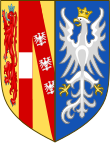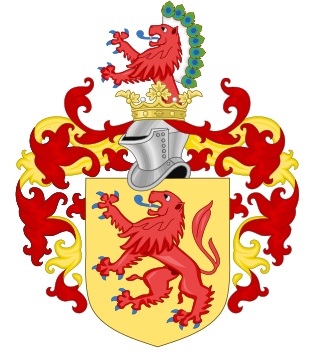
The House of Hapsburg, also known as the House of Austria, was one of the most prominent and important dynasties in European history.

The House of Este is a European dynasty of North Italian origin whose members ruled parts of Italy and Germany for many centuries.

The House of Lorraine originated as a cadet branch of the House of Metz. It inherited the Duchy of Lorraine in 1473 after the death without a male heir of Nicholas I, Duke of Lorraine. By the marriage of Francis of Lorraine to Maria Theresa of Austria in 1736, and with the success in the ensuing War of the Austrian Succession (1740–1748), the House of Lorraine was joined to the House of Habsburg and became known as the House of Habsburg-Lorraine. Francis, his sons Joseph II and Leopold II, and his grandson Francis II were the last four Holy Roman emperors from 1745 until the dissolution of the empire in 1806. The House of Habsburg-Lorraine inherited the Habsburg Empire, ruling the Austrian Empire and then Austria-Hungary until the dissolution of the monarchy in 1918.

The Duchy of Modena and Reggio was an Italian state created in 1452 located in Northwestern Italy, in the present day region of Emilia-Romagna. It was ruled since its establishment by the noble House of Este, and from 1814 by the Austria-Este branch of the family. The Este dynasty was a great sponsor of the arts, making the Duchy a cultural reference during the Renaissance and Baroque periods.

Francis IV Joseph Charles Ambrose Stanislaus was Duke of Modena, Reggio, and Mirandola, Duke of Massa and Prince of Carrara, Archduke of Austria-Este, Royal Prince of Hungary and Bohemia, Knight of the Order of the Golden Fleece.

Francis V, Duke of Modena, Reggio and Guastalla, Archduke of Austria-Este, Royal Prince of Hungary and Bohemia, Duke of Mirandola and of Massa, Prince of Carrara was a reigning prince. He was Duke of Modena, Reggio, and Mirandola, Duke of Guastalla from 1847 and Duke of Massa and Prince of Carrara from 1846 to 1859. His parents were Francis IV of Modena and Princess Maria Beatrice of Savoy. He was the last reigning duke of Modena before the duchy was incorporated into the Kingdom of Italy.

This is a list of rulers of the estates owned by the Este family, which main line of Marquesses rose in 1039 with Albert Azzo II, Margrave of Milan. The name "Este" is related to the city where the family came from, Este.

The Duchy of Massa and Principality of Carrara was a small state that controlled the towns of Massa and Carrara from 1473 until 1836.

Archduke Ferdinand Karl of Austria-Este was a son of Holy Roman Emperor Franz I and Maria Theresa of Austria. He was the founder of the House of Austria-Este and Governor of the Duchy of Milan between 1765 and 1796. He was also designated as the heir to the Duchy of Modena and Reggio, but he never reigned, owing to the Napoleonic Wars.

Robert, Archduke of Austria-Este, was the second son of Charles I, (beatified) last Emperor of Austria-Hungary, and Princess Zita of Bourbon-Parma. He was also known as Robert Karl Erzherzog von Österreich.

Maria Beatrice of Savoy was Duchess of Modena by marriage to Francis IV, Duke of Modena.
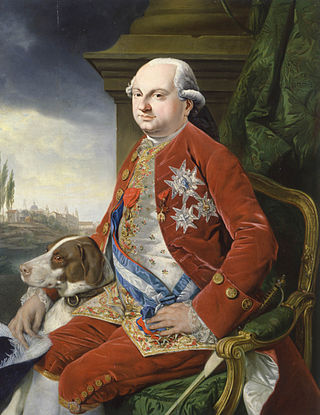
Ferdinand I was Duke of Parma, Piacenza and Guastalla from his father's death on 18 July 1765 until he ceded the duchy to France by the Treaty of Aranjuez on 20 March 1801. He was a member of the Spanish House of Bourbon.

Ercole III d'Este was Duke of Modena and Reggio from 1780 to 1796, and later of Breisgau. He was a member of the House of Este.
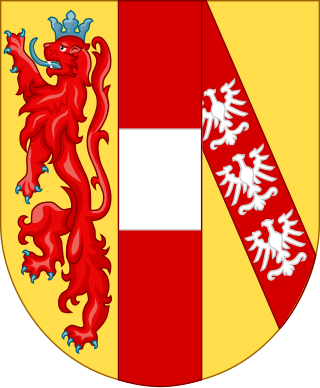
The House of Habsburg-Lorraine originated from the marriage in 1736 of Francis III, Duke of Lorraine and Bar, and Maria Theresa of Austria, later successively Queen of Bohemia, Queen of Hungary, Queen of Croatia and Archduchess of Austria. Its members are the legitimate surviving line of both the House of Habsburg and the House of Lorraine and inherit their patrimonial possessions from their female line of the House of Habsburg and from the male line of the House of Lorraine.

Francesco III d'Este was Duke of Modena and Reggio from 1737 until his death.
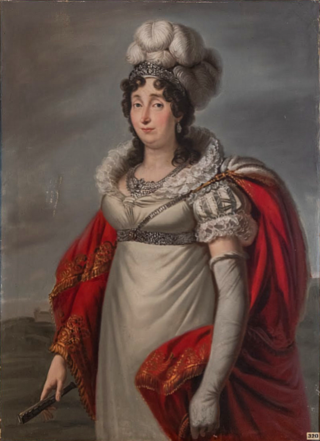
Maria Theresa of Austria-Este was Queen of Sardinia as the wife of Victor Emmanuel I of Sardinia. She was born an archduchess of Austria-Este and a princess of Modena as the daughter of Ferdinand Karl, Archduke of Austria-Este, and Maria Beatrice d'Este, Duchess of Massa. Her husband’s reign as King of Sardinia ended in abdication in 1821, when he elected his brother Charles Felix king after a liberal revolution, during which Victor Emmanuel proved unwilling to accept a liberal constitution. She was a part of the then newly-founded House of Austria-Este.
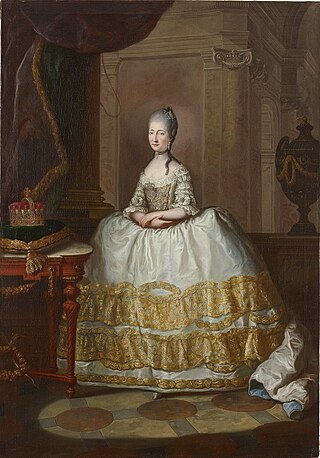
Maria Beatrice d'Este was the last descendant of the House of Este, of the House of Cybo-Malaspina and, through her maternal grandmother Ricciarda, also of the House of Gonzaga of Novellara and Bagnolo. Ducal princess of Modena and Reggio, she became the sovereign duchess of Massa and Carrara from 1790 until 1796 and from 1815 until her death in 1829. Through her marriage, she was co-founder of the new House of Austria-Este.

Ferdinand Karl Viktor was Archduke of Austria-Este and Prince of Modena.

Maria Teresa Cybo-Malaspina was sovereign Duchess of Massa and Princess of Carrara from 1731 until her death in 1790. From 1780, she also formally held the title of Duchess consort of Modena and Reggio as the wife Ercole III d'Este.

The grand title of the emperor of Austria was the official list of the crowns, titles, and dignities which the emperors of Austria carried from the foundation of the empire in 1804 until the end of the monarchy in 1918.
